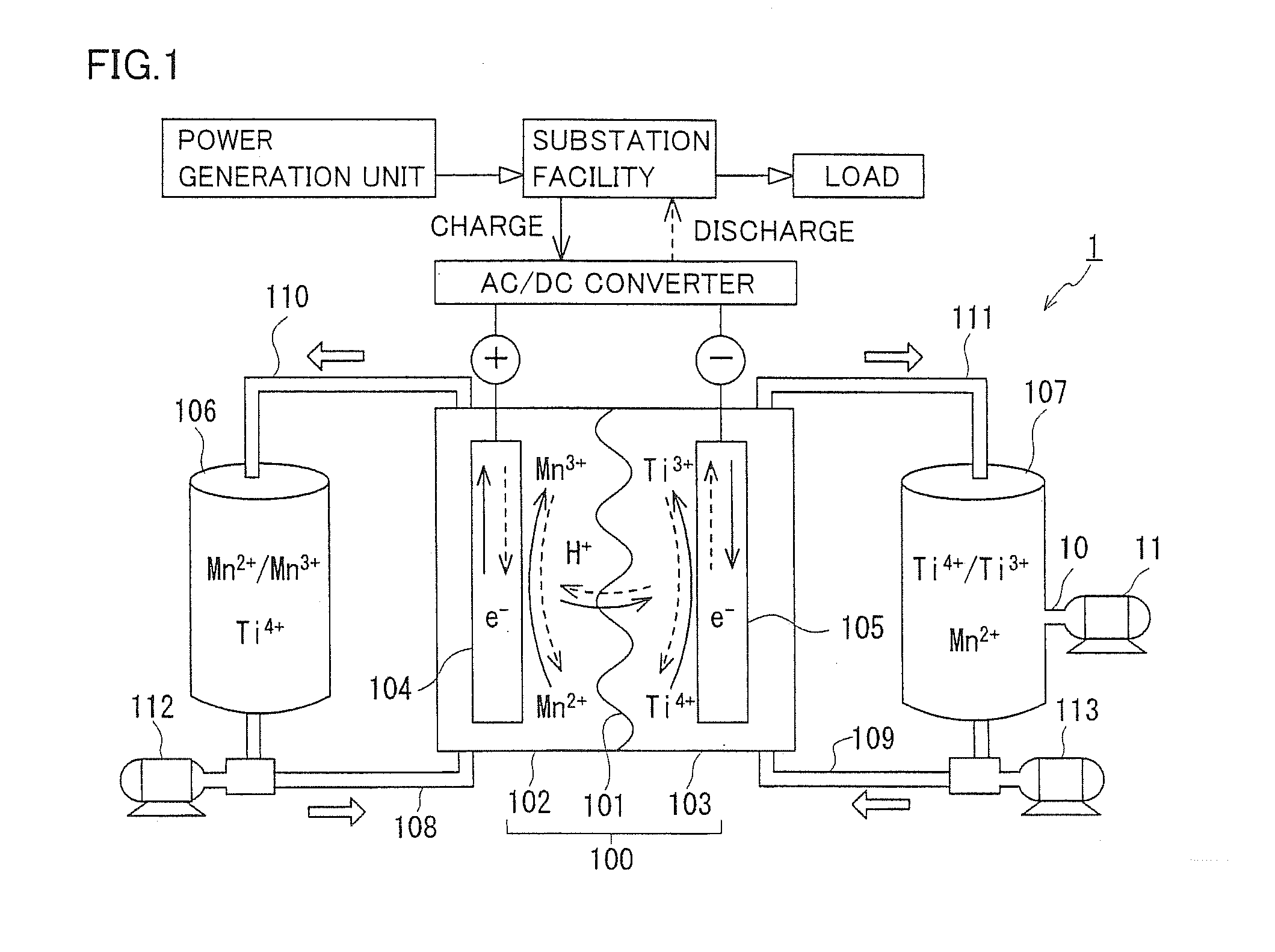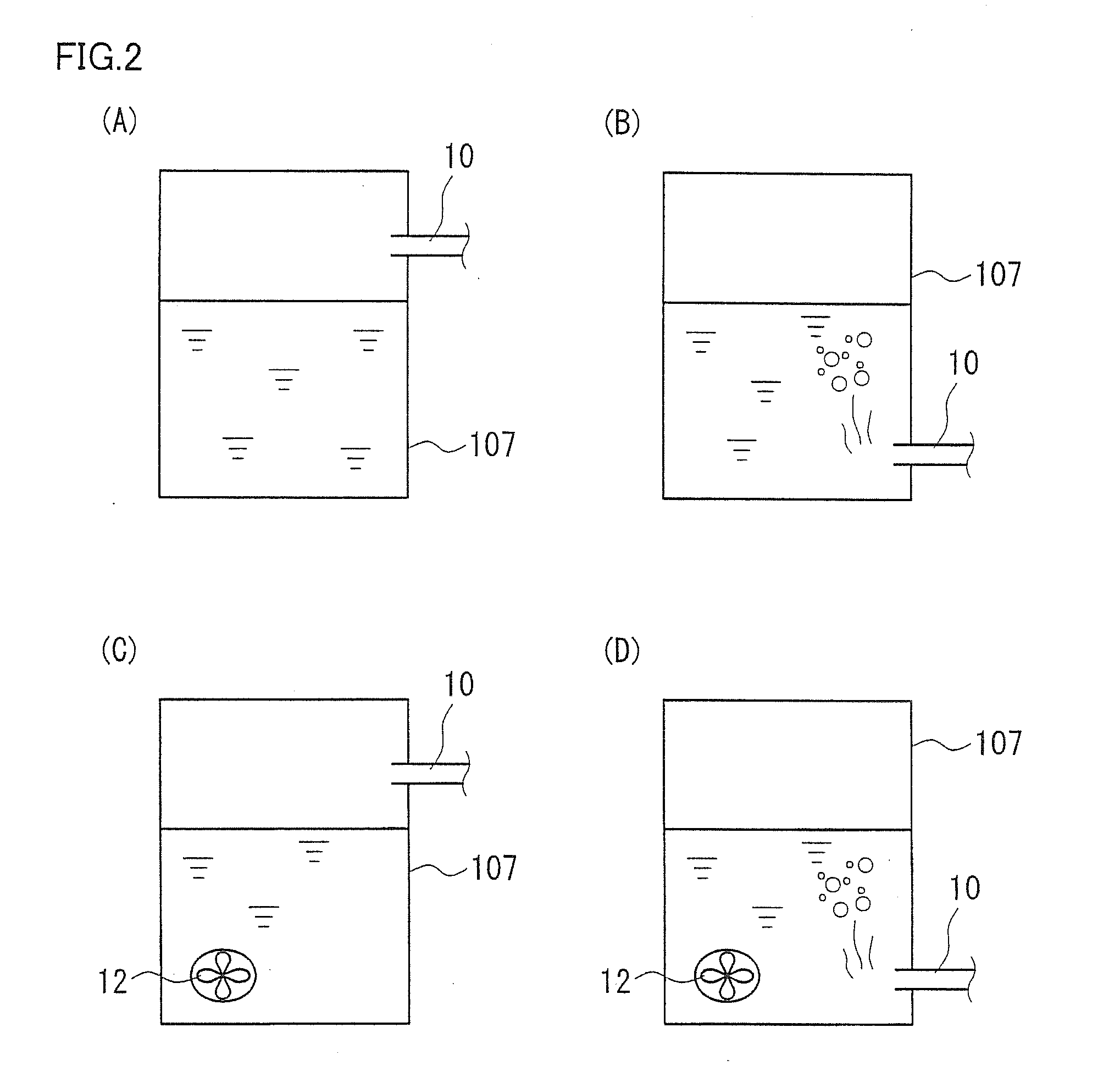Redox flow battery and method of operating the same
a redox flow battery and flow current technology, applied in the direction of fuel cells, indirect fuel cells, electrochemical generators, etc., can solve the problems of power system operation, difficulty in maintaining frequency and voltage, etc., and achieve the effect of reducing the battery capacity of the redox flow battery, high electromotive force, and reducing the cost of the invention
- Summary
- Abstract
- Description
- Claims
- Application Information
AI Technical Summary
Benefits of technology
Problems solved by technology
Method used
Image
Examples
first embodiment
[0046]>
[0047]A redox flow battery (hereinafter referred to as RF battery) 1 containing a Mn ion as a positive electrode active material and a Ti ion as a negative electrode active material will be generally described with reference to FIGS. 1 and 2. In FIG. 1, solid line arrows indicate charge, and broken line arrows indicate discharge. FIG. 1 illustrates metal ions in their representative forms, and forms other than those illustrated may be included. For example, while FIG. 1 shows Ti4+ as a tetravalent Ti ion, another form such as TiO2+ may be included.
[0048]As shown in FIG. 1, RF battery 1 is representatively connected through an AC / DC converter to a power generation unit (e.g., a solar photovoltaic power generator, a wind power generator, or a common power plant) and to a load such as a power system or a consumer, is charged with the power generation unit as a power supply source, and is discharged to provide power to the load. As with a conventional RF battery, RF battery 1 inc...
second embodiment
[0065]In a second embodiment, an RF battery 2 including additional features to the structure in the first embodiment will be described with reference to FIG. 3. FIG. 3 is a simplified diagram only illustrating how the ducts are connected.
[0066]>
[0067]In addition to the structure of the RF battery in the first embodiment, RF battery 2 in the second embodiment includes a gas-phase communicating tube 13, a liquid-phase communicating tube 14, a positive-electrode-side introduction duct 15, and a positive-electrode-side supply mechanism 16.
[0068][Gas-Phase Communicating Tube]
[0069]Gas-phase communicating tube 13 is a duct bringing the gas phase of positive electrode tank 106 in communication with the gas phase of negative electrode tank 107. By providing gas-phase communicating tube 13, oxygen generated by side reaction on the positive electrode side due to charge and discharge can be introduced into negative electrode tank 107. Preferably, gas-phase communicating tube 13 is provided wit...
first experimental example
[0080]RF battery 2 having a structure similar to that in the second embodiment described with reference to FIG. 3 was fabricated. As the positive electrode electrolyte and the negative electrode electrolyte, an electrolyte containing sulfuric acid having a concentration of 2M, MnSO4 (Mn2+) having a concentration of 1M, and TiOSO4 (Ti4+) having a concentration of 1M mixed therein was used. Tanks 106 and 107 were filled with 3 L of the positive electrolyte and 3 L of the negative electrolyte, respectively, in an airtight manner from the external atmosphere. The gas phase sections were filled with nitrogen gas in order to suppress oxidation. As battery element 100, a single cell having an electrode area of 500 cm2 employing a carbon felt electrode and a cation exchange membrane was used. Liquid-phase communicating tube 14 and gas-phase communicating tube 13 remained closed.
[0081]This experimentally fabricated Ti / Mn-based RF battery 2 was subjected to charge and discharge tests. The ini...
PUM
| Property | Measurement | Unit |
|---|---|---|
| oxidation-reduction potentials | aaaaa | aaaaa |
| oxidation-reduction potentials | aaaaa | aaaaa |
| oxidation-reduction potential | aaaaa | aaaaa |
Abstract
Description
Claims
Application Information
 Login to View More
Login to View More - R&D
- Intellectual Property
- Life Sciences
- Materials
- Tech Scout
- Unparalleled Data Quality
- Higher Quality Content
- 60% Fewer Hallucinations
Browse by: Latest US Patents, China's latest patents, Technical Efficacy Thesaurus, Application Domain, Technology Topic, Popular Technical Reports.
© 2025 PatSnap. All rights reserved.Legal|Privacy policy|Modern Slavery Act Transparency Statement|Sitemap|About US| Contact US: help@patsnap.com



